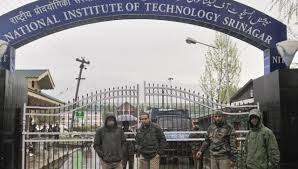Shujaat Bukhari
 The crisis that unfolded at National Institute of Technology (NIT) in Srinagar after West Indies defeated India in T20 World Cup semi-final snowballed in no time. It turned out to be the first challenge for Mehbooba Mufti’s government that had taken over only two days before that match. The demands put forth by the non-local students who heavily outnumber the locals are unusual to have come from campus of an educational institute. When the semi-final ended in India’s defeat, the reaction from both sides was on expected lines but no one knew that it would draw the battle lines in such a way.
The crisis that unfolded at National Institute of Technology (NIT) in Srinagar after West Indies defeated India in T20 World Cup semi-final snowballed in no time. It turned out to be the first challenge for Mehbooba Mufti’s government that had taken over only two days before that match. The demands put forth by the non-local students who heavily outnumber the locals are unusual to have come from campus of an educational institute. When the semi-final ended in India’s defeat, the reaction from both sides was on expected lines but no one knew that it would draw the battle lines in such a way.
At a time when the debate on nationalism in India has assumed a new dimension and the harassment of Kashmiri students in rest of India has become a routine, the local students cheering for a team playing against India should not have come as a surprise.
Kashmir has been witnessing conflict since 1989 and Government of India has been fighting a two-fold battle of containing armed rebellion and political alienation. The latter has increased in the past few years with the public unrest taking a centre stage.
Giving vent to this sense of political dissatisfaction is not new in Kashmir. When India played against West Indies and Australia in 1983 and 1986, Kashmiris did not cheer for India and at that time there was no political uprising or militancy in Kashmir. Much has changed since then and politically, the distance between Srinagar and Delhi has increased so much. However, whatever happened at NIT campus cannot be condoned. Police could have avoided the alleged brutality against the students but to follow it up with handing over the campus to Central Reserve Police Force (CRPF) widened the gulf between locals and non-locals.
Reality remains shrouded in layers of more than one version. The non-locals have leveled serious charges against local students, which constitute just 25 percent of total strength in NIT. They leveled charges of brutality against police, not being allowed to exhibit patriotism on campus and the tricolour being confiscated. These charges could be investigated and the “culprits” could be booked but the demand that NIT should be shut and shifted out of Kashmir had dangerous dimensions. Not only was it possible for the GoI to concede to this demand but also it would mean pushing Kashmir to the wall. Under the garb of “security issue” the students cannot demand migration when thousands of them have been enjoying their time in the college since 2004 when it was rechristened as NIT from Regional Engineering College. As of now there are over 3000 students studying in NIT, pursuing Bachelor’s degree, M Tech and doctorate. Out of them just 25 percent are local students. One of the faculty members who spoke to me on condition of anonymity said for the last 16 years non-local students have been studying here and not a single one has been harmed. “The incident on the day of T20 semi-finals was unfortunate one and could have settled down on its own,” he said.
Unfortunately, the students fell in the trap of demonstrating patriotism on the campus and the crisis witnessed at JNU and Hyderabad University reverberated in Srinagar though in a reverse direction. So far one could see the non-locals mixing up with the locals not only in campus but also in markets, in café’s and in the neighbouring Kashmir University. But the way government chose to settle it down making it a “central subject” by handing over campus to CRPF, stamping the version of Jammu and Kashmir Police’s alleged brutality and not leaving it to the wisdom of local administration to sort out the issue, the future of thousands of students was jeopardized as they were isolated and would take long time to restore pre-March 31 situation.
The Centre should have reposed faith in local government, of which BJP is a part and allowed it to negotiate with the students. Ironically the media was banned from entry, representatives of seven local trade bodies who wanted to go in and talk to agitating students assuring them safety were not allowed and all doors of reconciliation through locals were shut.
In this hour of crisis, when efforts should have been made to douse the raging fire, a section of national media contributed in worsening the situation. This led to politicization of the issue and also resulted in harassment and beating of some Kashmiri students in rest of India. The media gave an impression as if some forces were at war with non-local students in NIT. However, the maturity with which it was dealt by the separatist leaders such as Syed Ali Geelani and Mirwaiz Umar Farooq assuring them complete safety and asking people to ensure that was much appreciable.
Some elements like Bollywood actor Anupam Kher and a group of students patronized by a BJP leader R P Singh in Delhi tried to further instigate the students by making a bid to reach out to them in “solidarity”. But good sense prevailed on the government, which stopped those saboteurs and did not allow them to enter state. Chief Minister Mehbooba Mufti also termed it a non-issue and the Deputy Chief Minister Nirmal Singh spent some time with them to bring situation under control. Authorities have taken a step in right direction by allowing the non-local students to go back to their home and cool off for some time.
While the dust would settle down, it leaves a serious lesson for the government to learn. Particularly the central government in Delhi must understand that such situations are best to be left to local administration. Handing over the campus to paramilitary CRPF and rushing a team from Human Resource Development Ministry and creating a space for Jammu and Kashmir Police bashing, did not help to control the situation. The central government must have reposed faith in the state government and not allowed itself to be exploited under emotional blackmail. If the good sense would not have prevailed on the concerned, this incident would have caused much damage to Kashmir’s image outside. Matches will be played and there will be people cheering for different teams but that should not lead to debates on nationalism and anti-nationalism. Academic institutions need to be freed from this virus.





